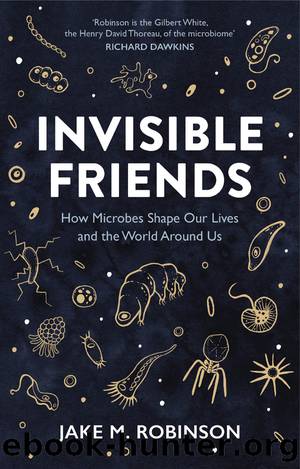Invisible Friends by Robinson Jake;

Author:Robinson, Jake;
Language: eng
Format: epub
Publisher: Pelagic Publishing
Scanning electron microscope images showing the probiotic wall material porosity at 10Ã magnification (left), and the Bacillus subtilis cells dispersed within the material matrix as a biofilm at 2,500Ã magnification (right). Images provided by Richard Beckett.
This next story is about electricity, and eventually microbes, of course! In 1752, Benjamin Franklin conducted his famous experiment with a kite, a key and a lightning storm. He attached a wire to the top of the kite to act as a lightning rod. He secured a hemp string to the bottom of the kite, which conducted an electrical charge. The silk string he held in a dry barn deliberately prevented electrical conduction. He attached the metal key to the hemp string. During the storm, the loose threads on the hemp string started to stand erect, and when Franklin moved his finger towards the key, he felt a spark as the positive charges in his hand attracted the negative charges in the metal. He eventually used a Leyden jar to store the high-voltage electrical charge. This was one of the first recorded demonstrations of the connection between lightning and electricity. However, it was not the discovery of electricity, as many accounts document. Over 2,000 years before this event, the Ancient Greeks had discovered that rubbing fur on amber caused an electrical attraction.13 This is the first recorded discovery of static electricity. In the early twentieth century, archaeologists discovered pots with an iron rod and sheets of copper inside. Although the evidence is ropey, some believe this was an ancient battery that produced light in Roman times.14 By the seventeenth century, several electricity-related discoveries had been made, including an early electrostatic generator. Later in 1800, Alessandro Volta constructed an early battery â the voltaic pile â that produced a steady electric current, and in 1831 Michael Faraday created the electric dynamo, which enabled him to produce a constant electrical current. And with a blink of an eye in evolutionary timescales, we now have satellites, fMRI scanners, laptops, mobile phones, aeroplanes, automobiles and the internet.
Therefore, it is only relatively recently that humans have used electricity. You may then be surprised to learn that several common bacteria have been using â and even generating â electricity for millions of years. Enter Geobacter, the mud-dwelling bacteria!
Professor Derek Lovley, at the University of Massachusetts Amherst, is the head of the Geobacter Project.15 Derek and his team found that some bacteria naturally produce electricity. They discovered that Geobacter evolved the ability to âbreatheâ solid lumps of iron in the soil. By doing this, they can generate electricity. Humans can harvest this electricity from the bacteria using devices known as microbial fuel cells. The fuel cells have two electrodes. One is an anode, the other is a cathode, and the two link together by an electrical connection.
As we know, many organisms, including humans, inhale oxygen and exhale carbon dioxide. The Geobacter bacteria have a different strategy because they evolved without lungs and in environments that lack oxygen. The Geobacter ingest the organic
Download
This site does not store any files on its server. We only index and link to content provided by other sites. Please contact the content providers to delete copyright contents if any and email us, we'll remove relevant links or contents immediately.
| Administration & Medicine Economics | Allied Health Professions |
| Basic Sciences | Dentistry |
| History | Medical Informatics |
| Medicine | Nursing |
| Pharmacology | Psychology |
| Research | Veterinary Medicine |
Machine Learning at Scale with H2O by Gregory Keys | David Whiting(4177)
Fairy Tale by Stephen King(3220)
Will by Will Smith(2791)
Hooked: A Dark, Contemporary Romance (Never After Series) by Emily McIntire(2497)
Rationality by Steven Pinker(2291)
Friends, Lovers, and the Big Terrible Thing by Matthew Perry(2118)
The Becoming by Nora Roberts(2087)
Love on the Brain by Ali Hazelwood(1963)
The Strength In Our Scars by Bianca Sparacino(1776)
HBR's 10 Must Reads 2022 by Harvard Business Review(1776)
A Short History of War by Jeremy Black(1760)
Leviathan Falls (The Expanse Book 9) by James S. A. Corey(1647)
515945210 by Unknown(1599)
A Game of Thrones (The Illustrated Edition) by George R. R. Martin(1588)
Bewilderment by Richard Powers(1537)
443319537 by Unknown(1468)
The 1619 Project by Unknown(1384)
The Real Anthony Fauci: Bill Gates, Big Pharma, and the Global War on Democracy and Public Health (Childrenâs Health Defense) by Robert F. Kennedy(1366)
Fear No Evil by James Patterson(1277)
